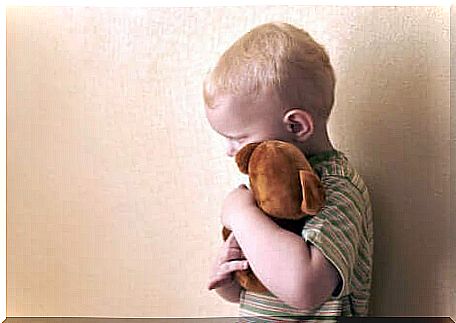How To Break Down Children’s Fears

It is very common for children to have fears and for them to change according to their age, but sometimes these fears block them and interfere with their daily lives. Below, we’ll look at some tips that can be helpful in overcoming children’s fears.
To overcome a fear that we consider irrational, we must not run away from it or avoid it, but rather face it and break down its structure, confronting the thought that generates the fear with reality.
Fear has a positive side and a negative side. Do you want to know why? How can parents help allay their children’s fears? We recommend that you keep reading to discover all this.
How to break down children’s fears?
First, it’s important to know the difference between fear, phobia and anxiety.
- Fear. In certain situations, the body reacts with fear – and this is normal – as it helps us to protect ourselves from something we consider dangerous.
- Phobia. That’s when the fear becomes something irrational, that interferes significantly in the lives of those who feel.
- Anxiety. It usually occurs for diffuse reasons and there is no specific cause. Any situation is interpreted with uncertainty and generates that state.

How do children learn to be afraid?
Normally, the children are not born with fear, for they are acquired throughout childhood, often influenced by parents. For example, when we yell “Stay away from that dog, he might bite you!” , this makes the child afraid of dogs. Therefore, it is important to be careful when saying sentences that can frighten or generate fear in children.
We must also be careful when showing insecurity in the face of any fear we have, because if the little one sees his reference figure in fear, he will also learn to be afraid of this situation.
Is it good to be afraid?
Fear is normal, as long as it is a physiological response to a stimulus or dangerous situation. It activates the body to escape, increasing the heart rate, making us breathe faster and tensing our muscles to prepare ourselves in case we have to run away from something that could put our physical integrity at risk.
When does it become a problem? When the child’s fear is of something that is not life-threatening, such as darkness or ghosts. This fear is somewhat irrational, given a situation that is not dangerous, and therefore the physiological response that occurs is wrong.
Can we educate with fear?
Not with fear itself, but it is important to explain to our children some situations that can involve danger, such as crossing the street without holding our hand, not looking or not respecting the traffic lights. Another thing that should be explained, but without mentioning the word fear, is that they shouldn’t speak or accept anything from someone they don’t know.
So instead of using phrases like “Be afraid of strangers” or “Be afraid of crossing the street” , it’s better to say “Be careful when crossing and try not to talk to strangers” .
Overthrowing Children’s Fears: How Do Fears Manifest at Different Ages?
- From 6 months to 2 years. Before 6 months, it was observed that there is no fear per se, only the fear of distance when children stay away from their parents or meet someone they don’t know.
- From 2 to 6 years old. Here, the fears of imaginary beings, such as ghosts, monsters, begin to emerge… It is at this age that phobias begin to appear, especially of some animals.
- From 7 to 11 years old. At these ages, fears of imaginary beings disappear and fears related to everyday life, such as accidents, medical treatments, etc., begin to emerge .
- From 12 to 14 years old. In the pre-adolescence phase, fears related to social relationships arise , such as the fear of being without friends, of school failure, of not being accepted by the peer group…
- From 15 to 18 years old. To the fears of the previous stage, there is the fear of personal relationships or of not achieving achievements in sports or hobbies.

Tips for Overthrowing Children’s Fears
The main point is that children see their parents, who are their role models, as secure people, because this attitude will generate security in them.
Don’t stop them from facing what they fear
This will only create greater fear. Instead, you need to strategize to face that fear and overcome it. For this reason, children should not be allowed to avoid situations that generate fear. How to do this?
- Gradually facing the situation they fear.
- Giving them resources or tools so they know how to deal with them.
- Have an adult at your side who is a reference and offers security.
do not scold
Do not get angry or scold the child for being afraid of something that seems silly to you. Explain that it is normal to be afraid and that there is no need to be ashamed of it, but that this situation is not dangerous for her.
Analyze the dreaded situation
Teach the child to analyze the situation and tell him that he doesn’t have to be afraid of certain things. Also, point out that she may be afraid of something in particular just because it is unknown to her.
Teach guidelines to calm down
Teach breathing or relaxation techniques for a time when the child is feeling fear and give rational alternatives to think about whether or not that fear is substantiated.
On how to overcome children’s fears
We’ve already seen how fear works and what can be done to allay children’s fears. It is important to remember that if these tips are applied and the child continues to feel an irrational fear, which may eventually turn into a phobia, it will be necessary to see a specialist so that he or she can help.









